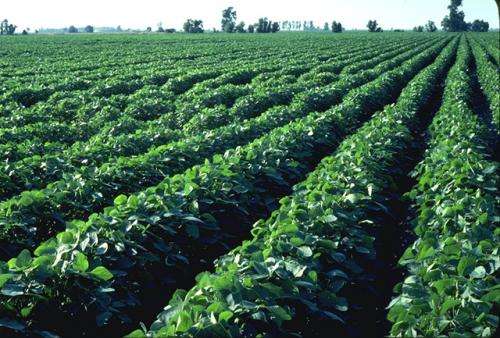Harvests in the U.S. to suffer from climate change, according to study

Some of the most important crops risk substantial damage from rising temperatures. To better assess how climate change caused by human greenhouse gas emissions will likely impact wheat, maize and soybean, an international team of scientists conducted an unprecedentedly comprehensive set of computer simulations of U.S. crop yields. The simulations reproduced a strong reduction in past crop yields induced by high temperatures, thereby confirming that they capture one main mechanism for future projections. Importantly, the scientists find that increased irrigation can reduce the negative effects of global warming on crops—but this is possible only in regions where sufficient water is available. Eventually, limiting global warming is needed to keep crop losses in check.
"We know from observations that high temperatures can harm crops, but now we have a much better understanding of the processes," says Bernhard Schauberger from the Potsdam Institute for Climate Impact Research, lead author of the study. "The computer simulations that we do are based on robust knowledge from physics, chemistry, biology; on a lot of data and elaborate algorithms. But they cannot represent the entire complexity of the crop system; thus, we call them models. In our study, they have passed a critical test." The scientists compare the model results to data from actual observations. Thusy, they can determine which critical factors to include in their calculations, including temperature, CO2, irrigation and fertilization.
Without efficient emission reductions, yield losses of 20 percent for wheat are possible by 2100
For every single day above 30°C, maize and soybean plants can lose about 5 percent of their harvest. The simulations have shown that the models capture the effects of small heat increases beyond this threshold, which result in abrupt and substantial yield losses. Such temperatures will be more frequent under unabated climate change and can severely harm agricultural productivity. Harvest losses from elevated temperatures of 20 percent for wheat, 40 percent for soybean and almost 50 percent for maize, relative to non-elevated temperatures, can be expected at the end of our century without efficient emission reductions. These losses do not even consider extremely high temperatures above 36°C, which are expected to lower yields further.
The effects go far beyond the U.S., one of the largest crop exporters; world market crop prices might increase, which is an issue for food security in poor countries.
Irrigation could be a means for adaptation—but only in regions where there's sufficient water
"The losses were substantially reduced when we increased the irrigation of fields in the simulation, so water stress resulting from temperature increase seems to be a bigger factor than the heat itself," says co-author Joshua Elliott from the University of Chicago. When water supply from the soil to the plant decreases, the small openings in the leaves gradually close to prevent water loss. This precludes the diffusion of CO2 into the cells, which is an essential building material for the plants. Additionally, crops respond to water stress by increasing root growth at the expense of above-ground biomass and, eventually, yields. "Irrigation therefore could be an important means of adaptation to dampen the most severe effects of warming," says Elliott. "However, this is limited by the lack of water resources in some regions."
Burning fossil fuels elevates the amount of CO2 in the air. This usually increases the water use efficiency of plants since they lose less water for each unit of CO2 taken up from the air. However, this cannot be confirmed as a safeguard of yields under high temperatures, the scientists argue. The additional CO2 fertilization in the simulations does not alleviate the drop in yields associated with high temperatures above about 30°C.
The comparison of different climate change simulations and their impacts is at the heart of the ISIMIP project (Inter-Sectoral Impacts Modelling Intercomparison Project) comprising about 100 modelling groups worldwide. The simulations are generated in cooperation with AgMIP, the international Agricultural Model Intercomparison and Improvement Project.
More information: Bernhard Schauberger, Sotirios Archontoulis, Almut Arneth, Juraj Balkovic, Philippe Ciais, Delphine Deryng, Joshua Elliott, Christian Folberth, Nikolay Khabarov, Christoph Müller, Thomas A. M. Pugh, Susanne Rolinski, Sibyll Schaphoff, Erwin Schmid, Xuhui Wang, Wolfram Schlenker, Katja Frieler (2017): Consistent negative response of US crops to high temperatures in observations and crop models. Nature Communications, DOI: 10.1038/NCOMMS13931
Journal information: Nature Communications
Provided by Potsdam Institute for Climate Impact Research


















